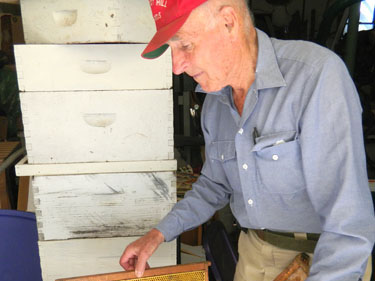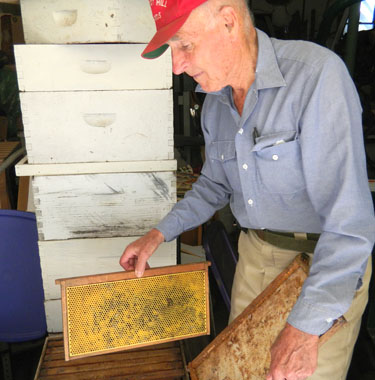

Lew Halprin photo
By Lew Halprin
It’s no secret that there are many apple farms in Stow, and during their growing and picking season, these farms provide a lot of part time employment to the residents of Stow, especially the younger residents. But there is one group of very young workers that work at the farms only 2-4 weeks in the early spring; yet without them, the farms, especially apple orchards, would not be successful. They are called ‘bees’. Not spelling bees, but honeybees.
I dropped over to see Richard Martin, the second generation (out of three) owner of Honey Pot Hill Orchard to find out more about this important part-time resident of Stow. It turns out that in early May, the orchard rents 75 hives from Florida for about $85/each to pollinate the apple trees whose blossoms are in full bloom about that time. The hives are owned by specialist farmers in Florida, and they are rented to farms first in Florida when it gets warm enough for blossoms to bloom, then the hives work their way up the East coast as the blossom season goes north. They became available to us in Stow in late April because of an early spring throughout the whole east coast.
Each hive has about 1000 bees. Deep in the hive is the queen bee, the only bee that reproduces, and she is responsible for the birth of all the other bees. A small number of bees, called drones, stay in or around the hive to take care of every need of the queen and keep the hive clean, orderly and safe. The rest of the bees, the worker bees, are out gathering honey. But these worker bees are fussy and only go hunting when the temperature is 70 degrees or better and the wind is not too strong.
The bees go out as far as a mile from their hive and bring back honey they collect from the blossoms and deposit it into a section of the hive that contains as many as 8 special chambers called ‘honeycombs’. This is the food that sustains the colony of bees throughout the rest of the year. These honeycomb chambers are removed periodically (at night) by the farmer to collect the honey. At least one of the chambers is always left full of honey for the bees in order to provide them food.
Collecting and selling honey is not the prime purpose of having these beehives at the farm. In the process of collecting honey, the bees, who have a fuzzy skin, cause the blossoms to be fertilized, and grow into a juicy apple. If there were no bee hives, many of the blossoms would become fertilized anyway by wind, wild bees, and other insects, but not as efficiently as is done with hives of bees. Even with all those bees helping, about 10% of the blossoms do not get pollinated and fall off.
Richard maintains two hives of bees near his house year round just for his own use, sort of as pets. Probably because of that, the area around his home has a large crop of healthy sunflowers, and a full stock of honey in his closet.
When asked if the name of his family’s farm most people simply call ‘Honey Pot’ had anything to do with the honeybees, he felt not. It is his understanding that a swamp located next to a hill is called a ‘honey pot’. That is probably why the hill where most of his family’s apple trees are located got the name ‘Honey Pot Hill’, and that is why the farm is named “Honey Pot Hill Orchard”.